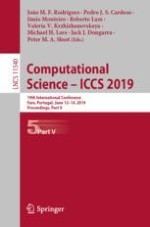The five-volume set LNCS 11536, 11537, 11538, 11539, and 11540 constitutes the proceedings of the 19th International Conference on Computational Science, ICCS 2019, held in Faro, Portugal, in June 2019.
The total of 65 full papers and 168 workshop papers presented in this book set were carefully reviewed and selected from 573 submissions (228 submissions to the main track and 345 submissions to the workshops). The papers were organized in topical sections named:
Part I: ICCS Main Track
Part II: ICCS Main Track; Track of Advances in High-Performance Computational Earth Sciences: Applications and Frameworks; Track of Agent-Based Simulations, Adaptive Algorithms and Solvers; Track of Applications of Matrix Methods in Artificial Intelligence and Machine Learning; Track of Architecture, Languages, Compilation and Hardware Support for Emerging and Heterogeneous Systems
Part III: Track of Biomedical and Bioinformatics Challenges for Computer Science; Track of Classifier Learning from Difficult Data; Track of Computational Finance and Business Intelligence; Track of Computational Optimization, Modelling and Simulation; Track of Computational Science in IoT and Smart Systems
Part IV: Track of Data-Driven Computational Sciences; Track of Machine Learning and Data Assimilation for Dynamical Systems; Track of Marine Computing in the Interconnected World for the Benefit of the Society; Track of Multiscale Modelling and Simulation; Track of Simulations of Flow and Transport: Modeling, Algorithms and Computation
Part V: Track of Smart Systems: Computer Vision, Sensor Networks and Machine Learning; Track of Solving Problems with Uncertainties; Track of Teaching Computational Science; Poster Track ICCS 2019
Chapter “Comparing Domain-decomposition Methods for the Parallelization of Distributed Land Surface Models” is available open access under a Creative Commons Attribution 4.0 International License via link.springer.com.
